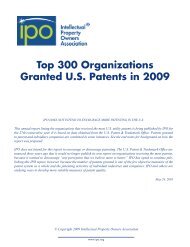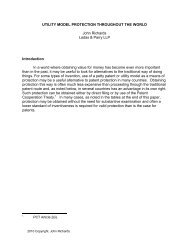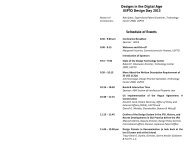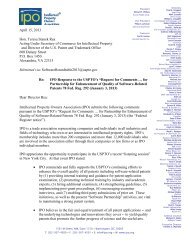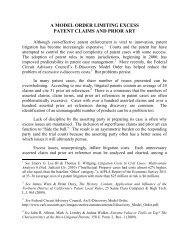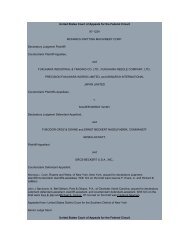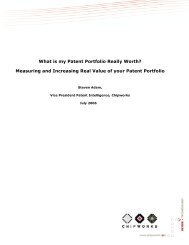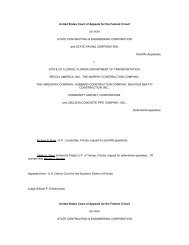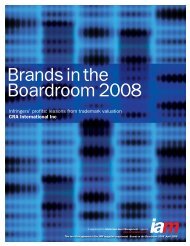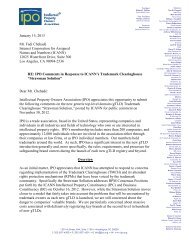Poly-America, LP v. GSE Lining Tech., Inc.
Poly-America, LP v. GSE Lining Tech., Inc.
Poly-America, LP v. GSE Lining Tech., Inc.
Create successful ePaper yourself
Turn your PDF publications into a flip-book with our unique Google optimized e-Paper software.
United States Court of Appeals for the Federal Circuit<br />
04-1022<br />
POLY-AMERICA, L.P.,<br />
Plaintiff-Appellee,<br />
v.<br />
<strong>GSE</strong> LINING TECHNOLOGY, INC.,<br />
Defendant-Appellant.<br />
Jerry R. Selinger, Jenkens & Gilchrist, of Dallas, Texas, argued for plaintiffappellee.<br />
With him on the brief were John C. Eichman and Timothy G. Ackermann.<br />
Donald R. Dunner, Finnegan, Henderson, Farabow, Garrett & Dunner, L.L.P., of<br />
Washington, DC, argued for defendant-appellant. With him on the brief were Thomas H.<br />
Jenkins and Rachel H. Townsend. Of counsel on the brief were T. Michael Wall, Gardere<br />
Wynne Sewell L<strong>LP</strong>, of Houston, Texas; and David M. Frischkorn, S. Richard Carden and<br />
Alison J. Baldwin, McDonell Boehnen Hulbert & Berghoff, of Chicago, Illinois.<br />
Appealed from:<br />
United States District Court for the Northern District of Texas<br />
Judge Sidney A. Fitzwater<br />
1
United States Court of Appeals for the Federal Circuit<br />
04-1022<br />
POLY-AMERICA, L.P.,<br />
v.<br />
Plaintiff-Appellee,<br />
<strong>GSE</strong> LINING TECHNOLOGY, INC.,<br />
Defendant-Appellant.<br />
___________________________<br />
DECIDED: September 14, 2004<br />
___________________________<br />
Before MICHEL, LOURIE, and RADER, Circuit Judges.<br />
LOURIE, Circuit Judge.<br />
<strong>GSE</strong> <strong>Lining</strong> <strong>Tech</strong>nology, <strong>Inc</strong>. (“<strong>GSE</strong>”) appeals from the post-trial decision of the<br />
district court denying its motion for judgment as a matter of law (“JMOL”) that two of <strong>Poly</strong>-<br />
<strong>America</strong>, L.P.’s (“<strong>Poly</strong>-<strong>America</strong>’s”) patents relating to landfill liner technology were invalid.<br />
<strong>Poly</strong>-<strong>America</strong>, L.P. v. <strong>GSE</strong> <strong>Lining</strong> <strong>Tech</strong>., <strong>Inc</strong>., No. 3:00-CV-1457-D (N.D. Tex. Aug. 13,<br />
2003) (“Post-Trial Order”). <strong>GSE</strong> also appeals from the denial of its motion for a new trial<br />
on damages. Id. Because we agree with the district court’s claim construction with<br />
respect to <strong>Poly</strong>-<strong>America</strong>’s patents and because there is sufficient evidence to support the<br />
jury’s verdict, we affirm the denial of JMOL of invalidity for both patents.<br />
However,<br />
because the district court erred in permitting <strong>Poly</strong>-<strong>America</strong> to claim the lost profits of a<br />
related corporation, <strong>Poly</strong>-Flex, <strong>Inc</strong>. (“<strong>Poly</strong>-Flex”), in its damages calculations, we reverse
the district court’s denial of <strong>GSE</strong>’s motion for a new trial on damages and remand for the<br />
district court to redetermine whether <strong>Poly</strong>-<strong>America</strong> has incurred lost profits.<br />
BACKGROUND<br />
<strong>Poly</strong>-<strong>America</strong>, L.P. 1<br />
owns United States Patents 5,763,047, directed to a threelayered<br />
textured landfill liner, and 5,804,112, covering a method for making such a liner.<br />
Both patents have an effective filing date of April 3, 1996, and both issued in 1998. The<br />
patents disclose a blown-film liner that comprises a smooth inner layer bonded to textured<br />
outer layers. The texture in the outer layers is created by a blowing agent that erupts<br />
during the extrusion process, producing a surface useful for gripping sloped dirt surfaces.<br />
The inner layer protrudes from the outer textured layers, and, when welded to the smooth<br />
portion of an adjoining sheet, it forms a strong seal to create an effective barrier for landfill<br />
use.<br />
The blown-film process employs a circular die to shape thermoplastic material into a<br />
long, hollow tube, and concentric channels in the die produce plastic sheets<br />
1<br />
<strong>Poly</strong>-<strong>America</strong>, L.P., the named appellee in this case, is the successor-ininterest<br />
of <strong>Poly</strong>-<strong>America</strong>, <strong>Inc</strong>., the corporation that originally filed suit. Similarly, <strong>GSE</strong> is the<br />
successor-in-interest of Serrot International, <strong>Inc</strong>., the initial defendant. The names of the<br />
parties were changed during the course of the lawsuit to reflect the parties now<br />
participating in this appeal. See <strong>Poly</strong>-<strong>America</strong>, L.P. v. <strong>GSE</strong> <strong>Lining</strong> <strong>Tech</strong>., <strong>Inc</strong>., No. 3:00-<br />
CV-1457-D, slip op. at 1 n.1 (N.D. Tex. Aug. 13, 2003).<br />
04-1022 2
having multiple layers. The extruded material is then cut into rectangular sheets. <strong>Poly</strong>-<br />
<strong>America</strong> claims that its innovation went against the traditional understanding about the<br />
process used to create blown-film liners.<br />
It asserts that before its invention, the<br />
prevailing belief in the industry was that balanced thermoplastic flow and uniform<br />
velocity within a blown-film die were critical parameters for normal production.<br />
In<br />
contrast, <strong>Poly</strong>-<strong>America</strong>’s invention called for blocking certain channels in the die that<br />
normally produced the outer layers, so that the liner would have a smooth layer without<br />
the textured portions.<br />
<strong>Poly</strong>-<strong>America</strong> claimed that a skilled artisan would not have<br />
intentionally obstructed a channel in a blown-film die for fear of damaging the equipment<br />
and incurring significant expense in repair and lost production time.<br />
In July 2000, <strong>Poly</strong>-<strong>America</strong>, <strong>Inc</strong>. sued Serrot International, <strong>Inc</strong>. (“Serrot”), alleging<br />
infringement of the ’047 and ’112 patents. Serrot moved for summary judgment of<br />
invalidity, arguing that <strong>Poly</strong>-<strong>America</strong>’s patents were invalid as anticipated. It argued that<br />
Gloucester Engineering manufactured for another company, Gundle <strong>Lining</strong> System, a<br />
die (“the Gundle die”) that was capable of performing the method claimed in the ’112<br />
patent. That machine, Serrot claimed, was sold in 1987 and thus is anticipatory prior art<br />
under the 35 U.S.C. § 102(b) on-sale bar. Serrot also asserted that the ’047 and ’112<br />
patent claims were anticipated or, in the alternative, were rendered obvious by another<br />
existing liner product, Friction Seal, made by a cast process, not a blown-film process.<br />
The district court rejected Serrot’s theories of invalidity, and it denied Serrot’s motion for<br />
summary judgment. <strong>Poly</strong>-<strong>America</strong>, <strong>Inc</strong>. v. Serrot Int’l, <strong>Inc</strong>., No. 3:00-CV-1457-D (N.D.<br />
Tex. Oct. 18, 2001) (“Claim Construction Order”).
Serrot thereafter conceded infringement, and the case proceeded to trial before a<br />
jury on Serrot’s invalidity defenses, willfulness, and damages. In December 2002, the<br />
jury returned a verdict in favor of <strong>Poly</strong>-<strong>America</strong>, <strong>Inc</strong>., concluding that the patents were<br />
not invalid and finding that Serrot had willfully infringed the patents. <strong>Poly</strong>-<strong>America</strong>, <strong>Inc</strong>.<br />
v. Serrot Int’l, <strong>Inc</strong>., No. 3:00-CV-1457-D, slip op. at 9-10, 17 (N.D. Tex. Dec. 19, 2002)<br />
(“Jury Verdict”).<br />
The jury awarded damages of $7.15 million in lost profits and a<br />
reasonable royalty of $5.08 million. Id. at 17.<br />
Following the jury verdict, <strong>GSE</strong> filed a post-trial motion for JMOL, arguing that the<br />
<strong>Poly</strong>-<strong>America</strong> patents were invalid for anticipation and obviousness. It also moved for<br />
JMOL or, alternatively, a new trial on damages, asserting that the jury’s award was<br />
against the great weight of the evidence. The district court denied <strong>GSE</strong>’s motions for<br />
JMOL of invalidity, but it did conclude that the jury’s reasonable royalty award was<br />
unreasonable to the extent that the amount was greater than the maximum reasonable<br />
royalty damages award that was supported by the trial evidence. The court conditioned<br />
the denial of <strong>GSE</strong>’s motion for a new trial on <strong>Poly</strong>-<strong>America</strong>’s acceptance of a remittitur<br />
of $266,502.00 of the reasonable royalty award. Post-Trial Order, slip op. at 26.<br />
<strong>Poly</strong>-<strong>America</strong> accepted the remittitur, and <strong>GSE</strong> now appeals from the denials of<br />
its motion for JMOL of invalidity and its motion for a new trial on damages. <strong>GSE</strong> does<br />
not appeal from the willfulness decision, nor is infringement at issue in this appeal. We<br />
have jurisdiction pursuant to 28 U.S.C. § 1295(a)(1).<br />
DISCUSSION<br />
We review a district court’s denial of a motion for JMOL of patent invalidity de<br />
novo, reapplying the standard used by the district court. Sextant Avionique, S.A. v.<br />
04-1022 4
Analog Devices, <strong>Inc</strong>., 172 F.3d 817, 824 (Fed. Cir. 1999). JMOL is appropriate when “a<br />
party has been fully heard on an issue and there is no legally sufficient evidentiary basis<br />
for a reasonable jury to find for that party on that issue.” Fed. R. Civ. P. 50(a)(1). When<br />
reviewing a court’s denial of JMOL, we must “determine whether viewing the evidence<br />
in the light most favorable to the non-moving party, and giving the non-movant the<br />
benefit of all reasonable inferences, there is sufficient evidence of record to support a<br />
jury verdict in favor of the non-movant.” Ericsson, <strong>Inc</strong>. v. Harris Corp., 352 F.3d 1369,<br />
1373 (Fed. Cir. 2003) (citation and internal quotation marks omitted).<br />
The denial of a motion for a new trial is an issue not unique to patent law; thus,<br />
we apply the law of the regional circuit in which the district court sits—in this case, the<br />
Fifth Circuit. See WMS Gaming <strong>Inc</strong>. v. Int’l Game <strong>Tech</strong>., 184 F.3d 1339, 1361 (Fed. Cir.<br />
1999). In the Fifth Circuit, “[t]he decision to grant or deny a motion for a new trial will be<br />
disturbed only for abuse of discretion or misapprehension of the law.” Woodfield v.<br />
Bowman, 193 F.3d 354, 358 (5th Cir. 1999) (citing Mitchell v. Lone Star Ammunition,<br />
<strong>Inc</strong>., 913 F.2d 242, 252 (5th Cir. 1990)). The Fifth Circuit affirms the denial of a motion<br />
for new trial “unless, on appeal, the party that was the movant in district court makes a<br />
clear showing of an absolute absence of evidence to support the jury’s verdict, thus<br />
indicating that the trial court had abused its discretion in refusing to find the jury’s verdict<br />
contrary to the great weight of the evidence.” Whitehead v. Food Max of Miss., <strong>Inc</strong>.,<br />
163 F.3d 265, 269 (5th Cir. 1998).<br />
A. The ’112 Patent<br />
On appeal, <strong>GSE</strong> argues as it did in the district court that <strong>Poly</strong>-<strong>America</strong>’s ’112<br />
method patent was anticipated by the sale of the Gundle die. <strong>GSE</strong> maintains that,<br />
04-1022 5
ecause the die was capable of performing the process that <strong>Poly</strong>-<strong>America</strong> later claimed,<br />
the sale of the die was a § 102(b) on-sale bar. It claims that the district court relied on<br />
and misinterpreted In re Kollar, 286 F.3d 1326 (Fed. Cir. 2002), as holding that a sale of<br />
a method does not constitute a sale within the meaning of § 102(b) until the method has<br />
been put into commercial practice. <strong>GSE</strong> argues that our decision in Minton v. National<br />
Ass’n of Securities Dealers, <strong>Inc</strong>., 336 F.3d 1373 (Fed. Cir. 2003), holds otherwise, so<br />
that even though the Gundle die may not have been used to carry out the claimed<br />
process before the critical date of <strong>Poly</strong>-<strong>America</strong>’s patent, its sale still represents a<br />
statutory bar to the patentability of the process. Additionally, it contends that the jury<br />
could not have reasonably concluded that the “choker slides” in the Gundle die were not<br />
the same as the “plugs” in the claims of the ’112 patent.<br />
<strong>Poly</strong>-<strong>America</strong> responds that the district court was correct to deny <strong>GSE</strong>’s motion<br />
for JMOL because the process later claimed in the ’112 patent was not ready for<br />
patenting when the Gundle die was sold in 1987. That defect, it argues, prevents the<br />
sale from becoming a bar to patentability. <strong>Poly</strong>-<strong>America</strong> asserts that our decision in<br />
Kollar is inapposite and that <strong>GSE</strong> has generally failed to show that the jury charge<br />
regarding the sale of the Gundle die was either erroneous or prejudicial. Also, <strong>Poly</strong>-<br />
<strong>America</strong> argues that the jury could have found a material difference between the<br />
“choker slides” and the claimed “plugs” and that such a finding was supported by<br />
substantial credible evidence.<br />
We agree with <strong>Poly</strong>-<strong>America</strong> that the district court properly denied <strong>GSE</strong>’s motion<br />
for JMOL. Our analysis begins with the relevant statute, 35 U.S.C. § 102(b) (2000),<br />
which provides in relevant part that “[a] person shall be entitled to a patent unless . . .<br />
04-1022 6
the invention was . . . on sale in this country, more than one year prior to the date of the<br />
application for patent in the United States . . . .” “Whether an invention is ‘on sale’ within<br />
the meaning of § 102(b) is a question of law based on underlying factual findings.”<br />
Kollar, 286 F.3d at 1329. Because a patent is presumed to be valid, 35 U.S.C. § 282<br />
(2000), and that presumption can be overcome only by clear and convincing evidence<br />
of facts to the contrary, the facts supporting the claim that a patent is invalid in view of<br />
an on-sale bar must be proved by clear and convincing evidence. Minton, 336 F.3d at<br />
1376.<br />
In Kollar, we considered whether a license agreement between an applicant’s<br />
assignee and another corporation was a proper basis for a § 102(b) on-sale bar. In that<br />
case, Kollar’s assignee and the corporation agreed to a license of a low-cost process for<br />
preparing various dialkyl peroxides. We stated that “the issue concerning the on-sale<br />
bar is not whether the process is physically represented or enabled by a written<br />
description, but whether the process has been commercialized.” 286 F.3d at 1333.<br />
Because the process needed development work in order to be commercially useful and<br />
to enable the product of the process to be sold, we held that neither the transfer of<br />
know-how regarding a claimed process nor that of a written description of a process met<br />
that standard, and thus neither qualifies as a “sale” within the meaning of § 102(b). Id.<br />
On the other hand, we decided in Minton that a lease of a computer program,<br />
one that implemented a claimed method and was guaranteed to operate properly,<br />
constituted a commercial offer for sale of the method. 336 F.3d at 1378. Whereas the<br />
transaction in Kollar involved mere know-how in need of development, the patentee in<br />
04-1022 7
Minton transferred a fully operational computer program capable of implementing the<br />
claimed method. Id.<br />
In the present case, the district court found that the Gundle die “was not used to<br />
produce textured blown-film liner with a smooth edge until April 2002,” Post-Trial Order,<br />
slip. op. at 8, well after the critical date of <strong>Poly</strong>-<strong>America</strong>’s ’112 patent. Moreover, there<br />
was evidence that it was not even known that the Gundle die could perform <strong>Poly</strong>-<br />
<strong>America</strong>’s process and that the use of blocked channels in the Gundle die clearly went<br />
against conventional wisdom. The Gundle die possessed choker slides, in contrast to<br />
the “plugs” of the ’112 patent claims. <strong>GSE</strong>’s argument that the Gundle die was capable<br />
of performing the claimed method is largely premised on the hindsight that its choker<br />
slides were able to achieve an objective they were not originally designed to do.<br />
Neither Kollar nor Minton is wholly on point here, so we need not parse out which<br />
case’s facts are closer to this one. Those cases involved licenses and leases of the<br />
claimed methods by the inventors, whereas this case involves a purported sale by a<br />
third party of a device asserted after the critical date to be usable in a claimed method.<br />
This case thus does not involve the policy prohibition against an inventor<br />
commercializing his invention while deferring the filing of a patent application. It does<br />
not involve a transaction with respect to the claimed method; it involves only a device<br />
different from that described in the patent for carrying out the claimed method. Thus,<br />
we conclude that the sale of the Gundle die was not an anticipation of the claimed<br />
method.<br />
In addition, there is substantial evidence in the trial record that the Gundle die’s<br />
“choker slides” functioned as devices for throttling purposes and not as “plugs” to block<br />
04-1022 8
the flow of material to produce a textured liner with a smooth edge, as required by the<br />
claims of the ’112 patent. Because the jury could have reasonably concluded that <strong>GSE</strong><br />
had not carried its burden of proving by clear and convincing evidence that <strong>Poly</strong>-<br />
<strong>America</strong>’s ’112 patent was invalid under the on-sale bar, we agree with the district court<br />
that substantial evidence supports the jury’s verdict and that <strong>Poly</strong>-<strong>America</strong>’s ’112 patent<br />
has not been shown to be invalid. Accordingly, we affirm the district court’s denial of<br />
<strong>GSE</strong>’s motion for JMOL of invalidity.<br />
B. The ’047 Patent<br />
<strong>GSE</strong> argues that <strong>Poly</strong>-<strong>America</strong>’s ’047 patent is invalid as anticipated or,<br />
alternatively, obvious in view of a similar liner called Friction Seal that was<br />
manufactured via a cast process by the National Seal Company as early as 1991. <strong>GSE</strong><br />
maintains that the district court erred by construing the preamble phrase “blown-film” as<br />
a substantive limitation in the claims of the ’047 patent. If the preamble is an integral<br />
part of the claims, then the claims are not invalid over the Friction Seal liner, which is<br />
not a “blown-film” liner. <strong>Poly</strong>-<strong>America</strong> asserts that the district court correctly construed<br />
the preamble language as a limitation, emphasizing the court’s analysis of the intrinsic<br />
evidence.<br />
It thus urges that the court properly denied <strong>GSE</strong>’s motion for JMOL of<br />
invalidity.<br />
Claim construction is a question of law that we review without deference. Cybor<br />
Corp. v. FAS <strong>Tech</strong>s., <strong>Inc</strong>., 138 F.3d 1448, 1456 (Fed. Cir. 1998) (en banc). A court may<br />
consider the specification, the prosecution history, and other relevant evidence when<br />
construing the scope of the claims. Pitney Bowes, <strong>Inc</strong>. v. Hewlett-Packard Co., 182<br />
F.3d 1298, 1309 (Fed. Cir. 1999).<br />
04-1022 9
“Whether to treat a preamble as a limitation is a determination resolved only on<br />
review of the entire[] . . . patent to gain an understanding of what the inventors actually<br />
invented and intended to encompass by the claim.” Corning Glass Works v. Sumitomo<br />
Elec. U.S.A., <strong>Inc</strong>., 868 F.2d 1251, 1257 (Fed. Cir. 1989). “No litmus test defines when a<br />
preamble limits claim scope.” Catalina Mktg. Int’l, <strong>Inc</strong>. v. Coolsavings.com, <strong>Inc</strong>., 289<br />
F.3d 801, 808 (Fed. Cir. 2002). On the one hand, a preamble is a claim limitation if it<br />
recites essential structure or steps, or if it is “necessary to give life, meaning, and<br />
vitality” to the claim. Pitney Bowes, 182 F.3d at 1305. On the other hand, a preamble is<br />
not limiting “where a patentee defines a structurally complete invention in the claim body<br />
and uses the preamble only to state a purpose or intended use for the invention.” Rowe<br />
v. Dror, 112 F.3d 473, 478 (Fed. Cir. 1997). “Further, when reciting additional structure<br />
or steps underscored as important by the specification, the preamble may operate as a<br />
claim limitation.” Catalina Mktg., 289 F.3d at 808.<br />
We agree with <strong>Poly</strong>-<strong>America</strong> that the phrase “blown-film” is a limitation of the<br />
claims of the ’047 patent. The specification is replete with references to the invention as<br />
a “blown-film” liner, including the title of the patent itself and the “Summary of the<br />
Invention.” The phrase is used repeatedly to describe the preferred embodiments, and<br />
the entire preamble “blown-film textured liner” is restated in each of the patent’s seven<br />
claims. Our analysis shows that the inventor considered that the “blown-film” preamble<br />
language represented an important characteristic of the claimed invention.<br />
We<br />
therefore agree with the district court’s conclusion that a “[r]eview of the entirety of the<br />
’047 patent reveals that the preamble language relating to ‘blown-film’ does not state a<br />
purpose or an intended use of the invention, but rather discloses a fundamental<br />
04-1022 10
characteristic of the claimed invention that is properly construed as a limitation of the<br />
claim itself.” Claim Construction Order, slip op. at 3. We further agree with the district<br />
court that the jury had the opportunity to fully consider <strong>GSE</strong>’s defense of invalidity for<br />
anticipation and obviousness and that there was substantial evidence to support its<br />
verdict.<br />
Consequently, we affirm the court’s denial of <strong>GSE</strong>’s motion for JMOL of<br />
invalidity for the ’047 patent.<br />
C. Lost Profits<br />
<strong>GSE</strong> argues that the district court improperly permitted <strong>Poly</strong>-<strong>America</strong> to claim lost<br />
profits on <strong>Poly</strong>-Flex’s lost sales. It alleges that <strong>Poly</strong>-Flex, even though it is a sister<br />
corporation to <strong>Poly</strong>-<strong>America</strong>, nonetheless lacks any exclusive rights and is hence not<br />
entitled to damages for infringement. Thus, it contends, the district court erred by<br />
treating <strong>Poly</strong>-<strong>America</strong> and <strong>Poly</strong>-Flex as a single economic unit and awarding <strong>Poly</strong>-<br />
<strong>America</strong> damages for lost profits on sales allegedly lost by <strong>Poly</strong>-Flex due to infringing<br />
sales by <strong>GSE</strong>.<br />
<strong>Poly</strong>-<strong>America</strong> responds that it operates together with <strong>Poly</strong>-Flex as a single<br />
economic unit for the purposes of production, marketing, and sales of the patented liner.<br />
It claims that the two corporations share a unity of interest that justifies treating them as<br />
a single economic unit for lost profits. Furthermore, it argues that <strong>Poly</strong>-Flex was more<br />
than a mere non-exclusive licensee and possessed certain substantive rights, including<br />
the “right of enforcement for claims for past damages” and the right to sublicense<br />
others, and that <strong>Poly</strong>-Flex could and did assign those rights to <strong>Poly</strong>-<strong>America</strong>. <strong>Poly</strong>-<br />
<strong>America</strong> cites a provision in its license agreement with <strong>Poly</strong>-Flex stating that, at least as<br />
between the parties, <strong>Poly</strong>-<strong>America</strong> is entitled to collect damages accruing to <strong>Poly</strong>-Flex<br />
04-1022 11
from any infringement of the ’047 and ’112 patents. For those reasons, <strong>Poly</strong>-<strong>America</strong><br />
asserts, the jury could have reasonably attributed <strong>Poly</strong>-Flex’s sales to <strong>Poly</strong>-<strong>America</strong>,<br />
and the district court correctly denied <strong>GSE</strong>’s motion for a new trial.<br />
We disagree with <strong>Poly</strong>-<strong>America</strong> and the district court that <strong>Poly</strong>-Flex’s lost profits<br />
are properly recoverable as if they were <strong>Poly</strong>-<strong>America</strong>’s own damages. Section 284 of<br />
Title 35 of the United States Code provides that a patentee shall be awarded “damages<br />
adequate to compensate for the infringement, but in no event less than a reasonable<br />
royalty.” In General Motors Corp. v. Devex Corp., 461 U.S. 648 (1983), the Supreme<br />
Court stated that Congress intended in § 284 that a “patent owner would in fact receive<br />
full compensation for ‘any damages’ [the patentee] suffered as a result of the<br />
infringement.” Id. at 654. Whether lost profits are legally compensable in a particular<br />
situation is a question of law that we review de novo. Rite-Hite Corp. v. Kelley Co., <strong>Inc</strong>.,<br />
56 F.3d 1538, 1544 (Fed. Cir. 1995) (en banc).<br />
It is true that the recovery of lost profits by a patentee is not limited to the<br />
situation in which the patentee is selling the patented device. However, the patentee<br />
needs to have been selling some item, the profits of which have been lost due to<br />
infringing sales, in order to claim damages consisting of lost profits. See id. at 1548-49.<br />
<strong>Poly</strong>-<strong>America</strong> apparently has not sold any item on which it claims damages to itself from<br />
<strong>GSE</strong>’s infringement.<br />
Although it is not clear here whether <strong>Poly</strong>-<strong>America</strong> has itself<br />
suffered lost profits from the infringement, a matter that may be dealt with on remand,<br />
<strong>Poly</strong>-<strong>America</strong> argues that <strong>Poly</strong>-Flex’s lost profits on its lost sales are legally<br />
compensable to <strong>Poly</strong>-<strong>America</strong>, its licensor. We disagree.<br />
04-1022 12
Even though <strong>Poly</strong>-<strong>America</strong> and <strong>Poly</strong>-Flex seem to share interests as two entities<br />
collaborating in the manufacture and sale of textured landfill liners, that relationship by<br />
itself is not sufficient to permit <strong>Poly</strong>-<strong>America</strong> to claim <strong>Poly</strong>-Flex’s lost profits from <strong>Poly</strong>-<br />
Flex’s lost sales. <strong>Poly</strong>-<strong>America</strong> and <strong>Poly</strong>-Flex have a common parent corporation and<br />
are not simply divisions of a single corporation, but are separate corporate entities.<br />
Their parent has arranged their corporate identities and functions to suit its own goals<br />
and purposes, but it must take the benefits with the burdens. While we do not speculate<br />
concerning the benefits that the two companies reap from dividing their operations and<br />
separating the owner of the patent from the seller of the patented product, <strong>Poly</strong>-<strong>America</strong><br />
and <strong>Poly</strong>-Flex may not enjoy the advantages of their separate corporate structure and,<br />
at the same time, avoid the consequential limitations of that structure—in this case, the<br />
inability of the patent holder to claim the lost profits of its non-exclusive licensee. While<br />
<strong>Poly</strong>-<strong>America</strong> may have the right to sue under its patents, both as an owner and as a<br />
back-licensee, it can recover only its own lost profits, not <strong>Poly</strong>-Flex’s.<br />
The provision of the license agreement between <strong>Poly</strong>-<strong>America</strong> and <strong>Poly</strong>-Flex<br />
providing that <strong>Poly</strong>-<strong>America</strong> “desires to have the contractual right to collect all damages<br />
accruing to <strong>Poly</strong>-Flex for certain past infringements of the Patents” does not change this<br />
situation. We have held that a licensee generally may not sue for damages unless it<br />
has exclusive rights under a patent, including the right to sue. See Rite-Hite, 56 F.3d at<br />
1552; Ortho Pharm. Corp. v. Genetics Inst., <strong>Inc</strong>., 52 F.3d 1026, 1032 (Fed. Cir. 1995).<br />
<strong>Poly</strong>-Flex does not have exclusive rights. It is clearly identified in the license agreement<br />
as a non-exclusive licensee, and as such, it received only a “bare license” and has no<br />
entitlement under the patent statutes to itself collect lost profits damages for any losses<br />
04-1022 13
it incurred due to infringement. Rite-Hite, 56 F.3d at 1552. Although parties to a lawsuit<br />
may allocate the disposition of infringement damages between themselves, as they<br />
appear to have done here, they cannot create lost profits for a patentee if there are<br />
none. Awarding lost profits to <strong>Poly</strong>-<strong>America</strong> on the basis of its private arrangement with<br />
<strong>Poly</strong>-Flex would synthetically create lost profits for <strong>Poly</strong>-<strong>America</strong>, when it may not have<br />
suffered any, to the detriment of <strong>GSE</strong>.<br />
We therefore conclude that the district court misapprehended the law of<br />
damages and lost profits and improperly denied <strong>GSE</strong>’s motion for a new trial on<br />
damages. Accordingly, we reverse that portion of the district court’s judgment and<br />
remand the case to determine whether there are any lost profits incurred by <strong>Poly</strong>-<br />
<strong>America</strong> due to <strong>GSE</strong>’s infringement, and, if not, the proper reasonable royalty to which<br />
<strong>Poly</strong>-<strong>America</strong> may be entitled.<br />
CONCLUSION<br />
For the reasons stated above, we affirm the district court’s denial of JMOL of<br />
invalidity for <strong>Poly</strong>-<strong>America</strong>’s ’112 and ’047 patents. We reverse the court’s denial of<br />
<strong>GSE</strong>’s motion for a new trial on damages and remand for further proceedings consistent<br />
with this opinion.<br />
COSTS<br />
Each party shall bear its own costs.<br />
AFFIRMED-IN-PART, REVERSED-IN-PART, AND REMANDED.<br />
04-1022 14



